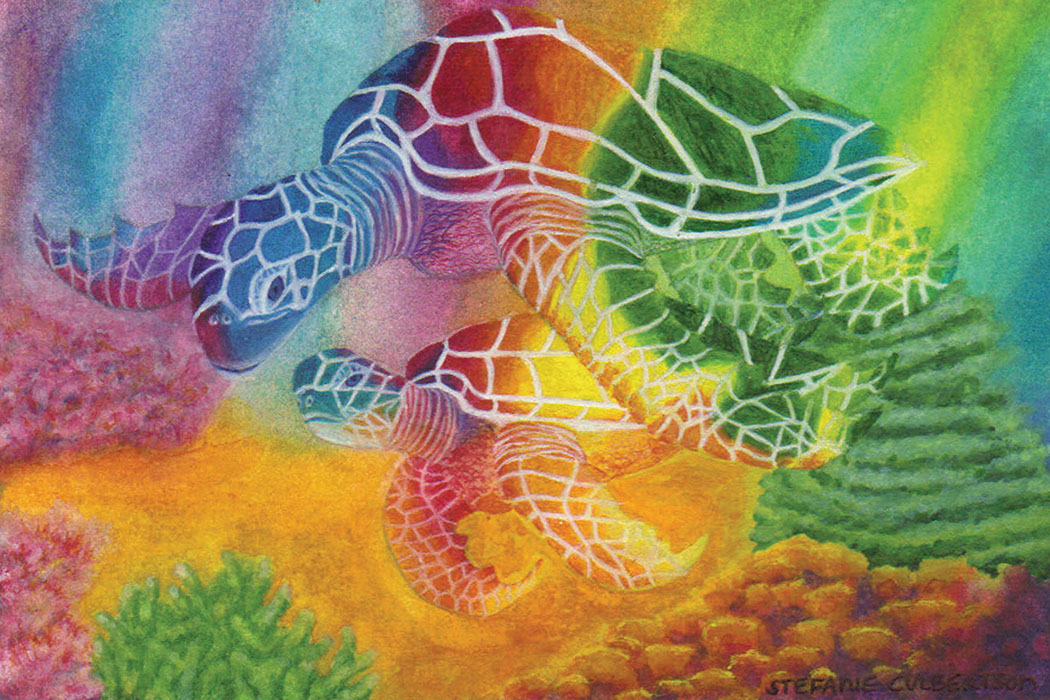Ali‘i Keana‘aina Shares Music From His Heart
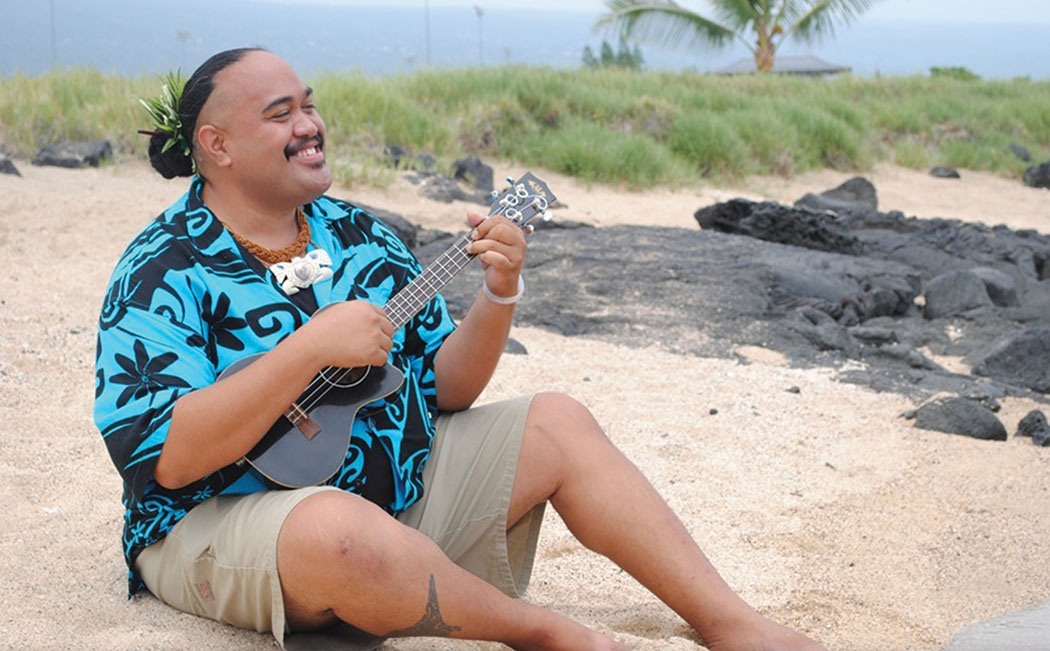 By Shirley Stoffer
By Shirley Stoffer
He is an imposing figure, being of large build, with a full head of long, wavy hair. Carved bone earrings spiral through his earlobes. He smiles, and any feeling of intimidation one might have first felt in his presence disappears. Hawai‘i Island’s Ali‘i Keana‘aina exudes an openness and sincerity that makes him a pleasure to be around, which is all the more enhanced by his masterful falsetto singing.
The use of a falsetto in music lifts the voice from its regular range into the upper register. It is often utilized in Hawaiian music and originates from a combination of sources: pre-European Hawaiian chanting, early Christian hymn singing, and the songs and yodeling of the Mexican immigrant paniolo (cowboys).
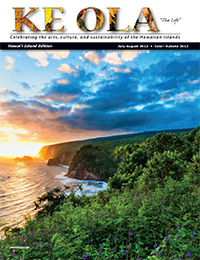
Ali‘i’s father, Norman Keana‘aina, was the youngest of 15 children. He performed with some of his brothers in the musical group, Keana‘aina Brothers, during the heyday of the Kona Inn and other “downtown” hotels during the ‘50s and ‘60s.
“The Brothers also played for the lū‘au show at the King Kamehameha Hotel, and their wives danced hula for it,” Ali‘i says.
These days, his father is known as Pastor Keana‘aina and presides over Mauna Ziona Congregational Church of Hawai‘i near Matsuyama Market in Kalaoa. The church’s services are celebrated in the Hawaiian language. His mother, Carol, was the church’s choir director while Ali‘i was growing up.
Well-known Kumu Hula, Roy Palacat, is Ali‘i’s uncle and is known to the family as “Uncle Bobo.”
“It’s thanks to him that I became an entertainer,” Ali‘i says. “I only played music in church until he asked some of my family to back up his hālau [hula group]. I was in ninth grade.”
When Ali‘i graduated from high school in 2001, he assisted his uncle with the Hawaiian Studies classes he taught at Kealakehe Elementary School.
“It was then I discovered my knack for writing music,” Ali‘i says. “Aunty Nona Beamer [the late noted Hawaiian educator and cultural preservationist] left us with some wonderful teaching tools—simple songs she wrote for teaching the alphabet, colors, numbers, and short Hawaiian phrases to children. I felt an urge to create my own. I started composing my own songs for teaching, and that created a snowball effect. I started learning the proper way to write a Hawaiian song from my cousin Kaina Keana‘aina. I also began studying falsetto singing with him.”
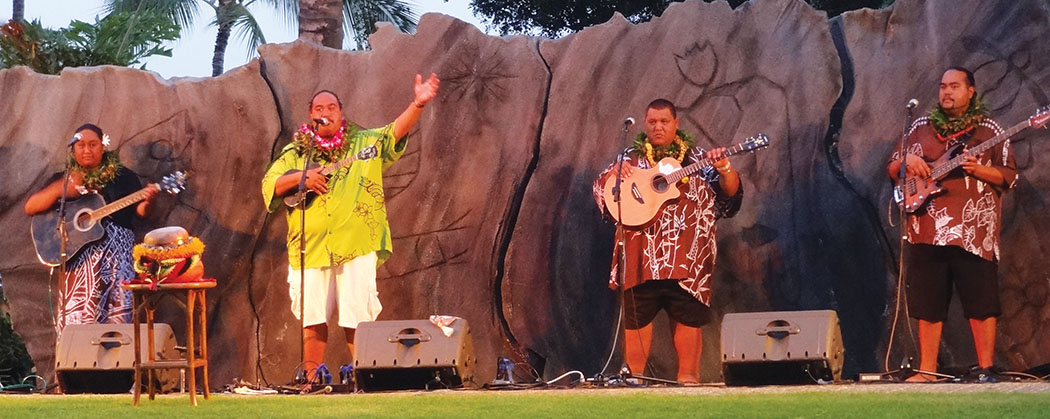
“There are certain components usually found in Hawaiian songs,” Ali‘i shares. One is the kauna (hidden meaning) that lies behind the lyrics. A reference to a flower might be an allusion to a woman, for instance.
“I had been tearing apart songs on my own to learn their form. Then, in August 2012, I attended the first Haku Mele [song writers] Retreat in Volcano, and I thought, ‘Oh, this would have made things SO much easier for me early on!’”
“It was around 2001 that I was introduced to the lū‘au world,” Ali‘i says. “I helped create a lū‘au for what’s now the Sheraton Kona Resort & Spa at Keauhou Bay and for what’s now the Courtyard King Kamehameha’s Kona Beach Hotel. I did chanting and singing, created some of the costumes, wrote a couple of the songs, and taught hula. I was the emcee for both of those lū‘au for a couple of years. It really helped me perfect my stage presence!”
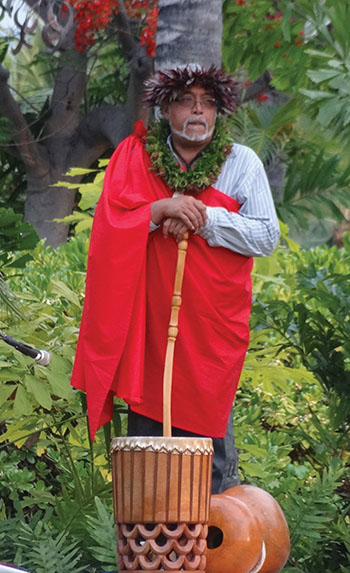
Ali‘i continues, “I have a hula group of my own, but I don’t call it a hālau. In the Hawaiian tradition, you must go through specific training and be given special permission from your kumu hula to teach. The training is very detailed in regard to traditional chanting, how and what foliage to gather, and what to wear. My group is just a ‘Hawaiian production.’ I very seldom touch on the Hawaiian gods and goddesses in it. For me, and for many other Hawaiians, there is some conflict with our Christian background.”
Ali‘i had begun learning hula when he was five years old from his cousin Kaina. “One of the reasons I stopped dancing was there are times when you’re in a hālau that you really need to dig deep into the cultural side of who we [Hawaiians] are as a people. I couldn’t resolve the question ‘How am I to give honor to Pele, when God is telling me there should only be One?’
“I feel I need to respect the Hawaiian culture,” Ali‘i continues, “so sometimes I will write a song for Pele. I’m expressing my love for who she is as a woman and a creator, so I feel that it’s ok for me to teach the song to my hula group since I wrote it.”
Because Ali‘i doesn’t want to “step on any toes” by performing the ancient songs and chants and because he believes there is a need to create contemporary Hawaiian music, he is inspired to write his own.
“I think it’s critical for us haku mele to compose music about what’s going on now with our culture, for future generations,” he says.
Preserving the Hawaiian language is important to Ali‘i.
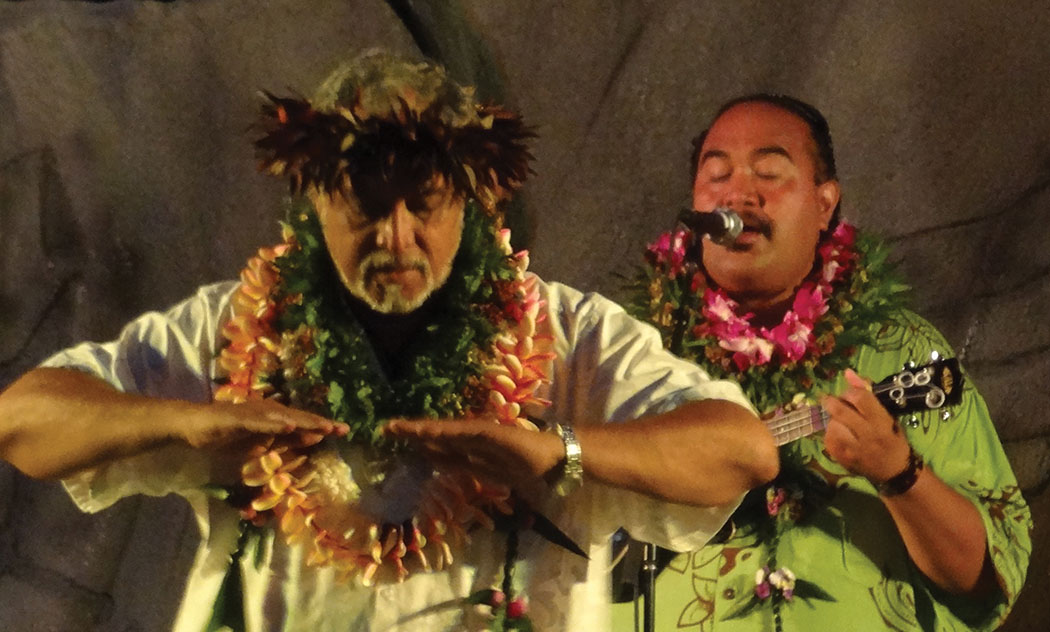
“When my brother came home one day and told me he had been at ‘Maks’ [pronounced mahks], I told him, ‘Don’t you EVER use that term around me again!’”
“Maks,” a shortened version of Makalawena, joins the list of other abbreviations like “A-Bay” for ‘Anaeho‘omalu Bay, that have been adapted for convenience by those unwilling to learn or use the Hawaiian names for places.
That practice contributes to a gradual disappearance of Hawaiian history and culture.
In 2010, Ali‘i won the 19th Annual Kindy Sproat Falsetto Storytelling Contest. The namesake of the competition, Clyde “Kindy” Sproat, was one of Hawai‘i’s most beloved falsetto singers. Raised in North Kohala, Kindy was a recipient of the National Endowment of the Arts’ National Heritage Award in 1988, and was considered to be a national treasure.
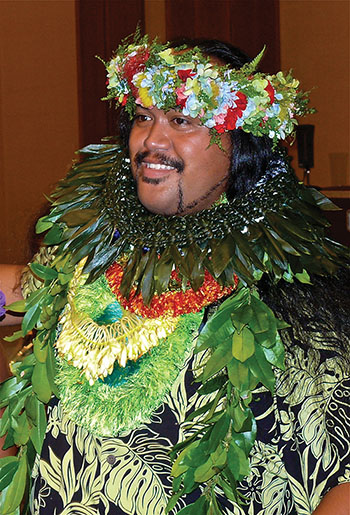
“I had been asked to enter the falsetto competition over the years, but I kept turning it down,” Ali‘i says. The day before the entry deadline for 2010 contest, he finally felt ready to enter. Next, he had to decide if he should sing a traditional Hawaiian song or one he had composed.
“I decided I had to step out on my own and do a song I’d written, not caring if it flopped. On the day of the competition, I was getting the message, ‘Ali‘i, it’s your turn. Why are you afraid?’ I didn’t want to step on stage with TOO much confidence. Then, I was notified that I would be the last contestant to perform,” he laughs.
“When it was my turn, I kicked off my slippers and just went out and did what I do. When the judges’ critiques arrived in the mail later, I was ecstatic to find out that they liked my song ‘A Heaha.’ It was a validation for me that I was going in the right direction with my songwriting. It was the highlight of my life so far,” Ali‘i says.
The creative momentum that began in his uncle’s classroom in 2001 culminated in the creation of Ali‘i’s first CD released in 2012. He Mele No (A Song For) is a collection of personal songs that Ali‘i wrote. Each is a tribute to special individuals in his life.
The song “Ka Nai‘a” (The Dolphin) was written for Ali‘i’s sister, Lani, whose ‘aumakua (guardian spirit) was the dolphin. She passed away unexpectedly in December 2010, soon after Ali‘i won the falsetto contest.
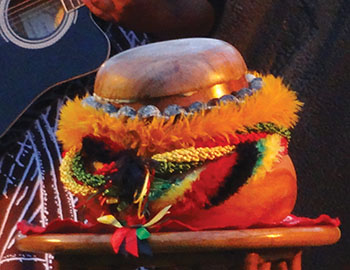
“Lani had always encouraged me to focus on being a Hawaiian music writer and performer rather than pursue the reggae or R&B styles I had dabbled in. Unbeknownst to me, right before she died she had arranged for me to be her main beneficiary. I was to receive all her stocks, her life insurance, etc., on one condition—that I record a CD. For some reason, Hula Records dropped out of their agreement to record the Falsetto Contest winner the year I won. And then I was gifted by my sister the means to do it myself,” he marvels. The album was engineered by Charles Brotman at Lava Tracks Studio in Waimea.
Ali‘i’s CD release concert at the Sheraton Kona Resort was also a CD release celebration for Kuana Torres Kahele of Nā Palapalai fame. Many of Ali‘i’s relatives were on stage with him during his segment of the concert, either playing in his backup band or dancing hula. ❖
Ali‘i is an activities coordinator for Wyndham Kona Hawaiian Resort. In addition to special events, he can be seen every third Friday at 6 pm in the hula show at Keauhou Shopping Center.
Contact Ali‘i Keana‘aina’s manager, Matthew Hanato: 325-9955, 896-0759, Matthew@lawakuaproductions.com
Contact writer Shirley Stoffer: shirley@konaweb.com
